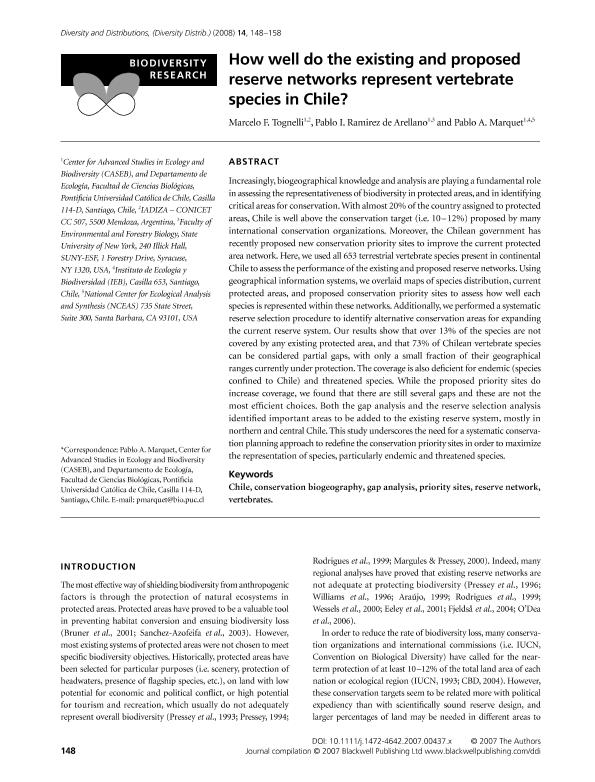Artículo
How well do the existing and proposed reserve networks represent vertebrate species in Chile?
Fecha de publicación:
01/2008
Editorial:
Wiley Blackwell Publishing, Inc
Revista:
Diversity and Distributions
ISSN:
1366-9516
Idioma:
Inglés
Tipo de recurso:
Artículo publicado
Clasificación temática:
Resumen
Increasingly, biogeographical knowledge and analysis are playing a fundamental role in assessing the representativeness of biodiversity in protected areas, and in identifying critical areas for conservation. With almost 20% of the country assigned to protected areas, Chile is well above the conservation target (i.e. 10-12%) proposed by many international conservation organizations. Moreover, the Chilean government has recently proposed new conservation priority sites to improve the current protected area network. Here, we used all 653 terrestrial vertebrate species present in continental Chile to assess the performance of the existing and proposed reserve networks. Using geographical information systems, we overlaid maps of species distribution, current protected areas, and proposed conservation priority sites to assess how well each species is represented within these networks. Additionally, we performed a systematic reserve selection procedure to identify alternative conservation areas for expanding the current reserve system. Our results show that over 13% of the species are not covered by any existing protected area, and that 73% of Chilean vertebrate species can be considered partial gaps, with only a small fraction of their geographical ranges currently under protection. The coverage is also deficient for endemic (species confined to Chile) and threatened species. While the proposed priority sites do increase coverage, we found that there are still several gaps and these are not the most efficient choices. Both the gap analysis and the reserve selection analysis identified important areas to be added to the existing reserve system, mostly in northern and central Chile. This study underscores the need for a systematic conservation planning approach to redefine the conservation priority sites in order to maximize the representation of species, particularly endemic and threatened species.
Archivos asociados
Licencia
Identificadores
Colecciones
Articulos(IADIZA)
Articulos de INST. ARG DE INVEST. DE LAS ZONAS ARIDAS
Articulos de INST. ARG DE INVEST. DE LAS ZONAS ARIDAS
Citación
Tognelli, Marcelo Fabio; De Arellano, Pablo I. Ramirez; Marquet, Pablo A.; How well do the existing and proposed reserve networks represent vertebrate species in Chile?; Wiley Blackwell Publishing, Inc; Diversity and Distributions; 14; 1; 1-2008; 148-158
Compartir
Altmétricas




